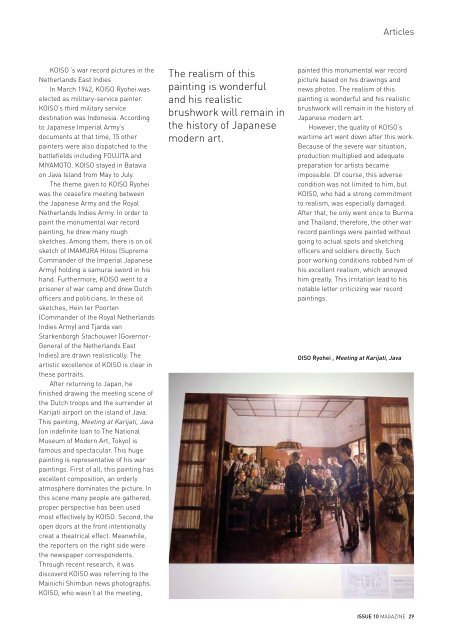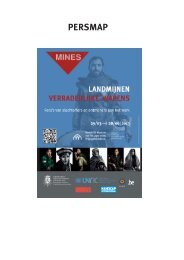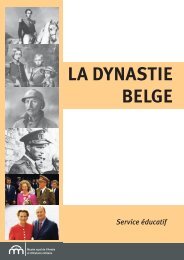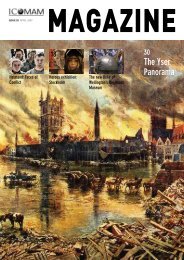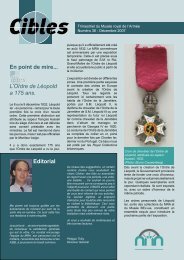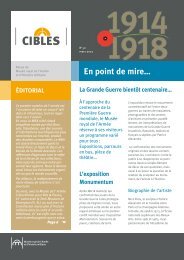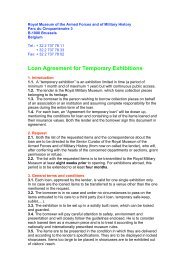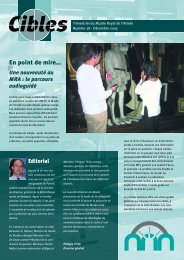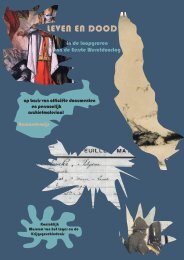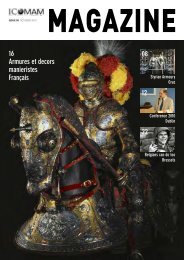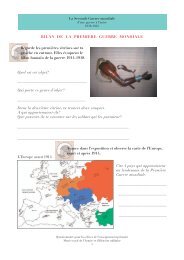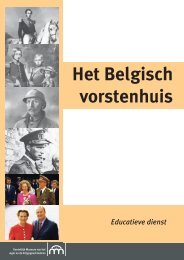Download issue 10, April 2013 (PDF 3MB)
Download issue 10, April 2013 (PDF 3MB)
Download issue 10, April 2013 (PDF 3MB)
- No tags were found...
Create successful ePaper yourself
Turn your PDF publications into a flip-book with our unique Google optimized e-Paper software.
ArticlesKOISO ’s war record pictures in theNetherlands East IndiesIn March 1942, KOISO Ryohei waselected as military-service painter.KOISO’s third military servicedestination was Indonesia. Accordingto Japanese Imperial Army’sdocuments at that time, 15 otherpainters were also dispatched to thebattlefields including FOUJITA andMIYAMOTO. KOISO stayed in Bataviaon Java Island from May to July.The theme given to KOISO Ryoheiwas the ceasefire meeting betweenthe Japanese Army and the RoyalNetherlands Indies Army. In order topaint the monumental war recordpainting, he drew many roughsketches. Among them, there is on oilsketch of IMAMURA Hitosi (SupremeCommander of the Imperial JapaneseArmy) holding a samurai sword in hishand. Furthermore, KOISO went to aprisoner of war camp and drew Dutchofficers and politicians. In these oilsketches, Hein ter Poorten(Commander of the Royal NetherlandsIndies Army) and Tjarda vanStarkenborgh Stachouwer (Governor-General of the Netherlands EastIndies) are drawn realistically. Theartistic excellence of KOISO is clear inthese portraits.After returning to Japan, hefinished drawing the meeting scene ofthe Dutch troops and the surrender atKarijati airport on the island of Java.This painting, Meeting at Karijati, Java(on indefinite loan to The NationalMuseum of Modern Art, Tokyo) isfamous and spectacular. This hugepainting is representative of his warpaintings. First of all, this painting hasexcellent composition, an orderlyatmosphere dominates the picture. Inthis scene many people are gathered,proper perspective has been usedmost effectively by KOISO. Second, theopen doors at the front intentionallycreat a theatrical effect. Meanwhile,the reporters on the right side werethe newspaper correspondents.Through recent research, it wasdiscoverd KOISO was referring to theMainichi Shimbun news photographs.KOISO, who wasn’t at the meeting,The realism of thispainting is wonderfuland his realisticbrushwork will remain inthe history of Japanesemodern art.painted this monumental war recordpicture based on his drawings andnews photos. The realism of thispainting is wonderful and his realisticbrushwork will remain in the history ofJapanese modern art.However, the quality of KOISO’swartime art went down after this work.Because of the severe war situation,production multiplied and adequatepreparation for artists becameimpossible. Of course, this adversecondition was not limited to him, butKOISO, who had a strong commitmentto realism, was especially damaged.After that, he only went once to Burmaand Thailand, therefore, the other warrecord paintings were painted withoutgoing to actual spots and sketchingofficers and soldiers directly. Suchpoor working conditions robbed him ofhis excellent realism, which annoyedhim greatly. This irritation lead to hisnotable letter criticizing war recordpaintings.OISO Ryohei , Meeting at Karijati, JavaISSUE <strong>10</strong> MAGAZINE 29


